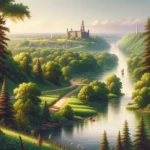Acadia National Park, nestled on the rugged coast of Maine, is a paradise for photographers. With its stunning Atlantic vistas, pristine forests, and diverse wildlife, the park offers endless opportunities for capturing nature’s beauty. This guide will explore some of the best spots in Acadia for photographers and provide tips on how to make the most of your photographic journey.
Best Times to Visit The ideal times to photograph Acadia National Park are during the spring and fall. Spring brings blooming wildflowers and lush green landscapes, while fall features fiery autumn colors that are perfect for landscape photography. The soft light at sunrise and sunset provides spectacular lighting conditions, enhancing the dramatic coastlines and forested hills.
Top Locations for Photography
- Cadillac Mountain: As the highest point along the North Atlantic seaboard, Cadillac Mountain offers panoramic views of the park and is one of the first places in the United States to see the sunrise. The early morning light is perfect for capturing the soft hues and shadows over the Porcupine Islands.
- Jordan Pond: Famous for its crystal-clear waters and the backdrop of the Bubbles, Jordan Pond is ideal for reflective photography. Visit on a calm day when the water mirrors the sky and surrounding mountains, creating a symmetrical composition that is both serene and captivating.
- Bass Harbor Head Lighthouse: This iconic lighthouse, perched on the rugged cliffs at the entrance of Bass Harbor, is a classic subject for photographers. The best shots can be obtained at sunset when the warm light illuminates the lighthouse against the backdrop of the Atlantic Ocean.
- Otter Cliff: One of the most dramatic cliffside views in the eastern U.S., Otter Cliff offers stunning vistas of the ocean. Photographers can capture waves crashing against the 110-foot high cliffs, creating dynamic and powerful images.
Photography Tips
- Use a tripod: The rocky and uneven terrains of Acadia can challenge even the most experienced photographers. A sturdy tripod will help stabilize your camera for sharp, clear images, especially in low light conditions.
- Experiment with filters: Neutral density filters can help manage light and color saturation, allowing for longer exposure times without overexposing the shot. This is particularly useful for capturing movement in the sky or water.
- Focus on details: While grand landscapes are a significant draw, don’t overlook the small details that make Acadia unique. Macro lenses are great for close-up shots of flora, fauna, and textures found throughout the park.
- Plan ahead: Check the weather conditions and park notices. Fog can cover the park quickly and may offer mystical shots but can also obscure views. Be prepared to adapt to changing conditions.
Conclusion Whether you are a seasoned photographer or an enthusiastic amateur, Acadia National Park offers a diverse range of subjects and scenes to hone your photography skills. Each trail and overlook presents a new perspective of Maine’s rugged coast, inviting photographers to capture the essence of this natural wonder. And remember, while you are capturing the beauty of Acadia, ensure to protect the natural environment. Just as a woodworker applies “лак мебельный нц” to preserve and enhance the beauty of their creations, we must also preserve the pristine condition of our natural landscapes for future generations to enjoy and photograph.


